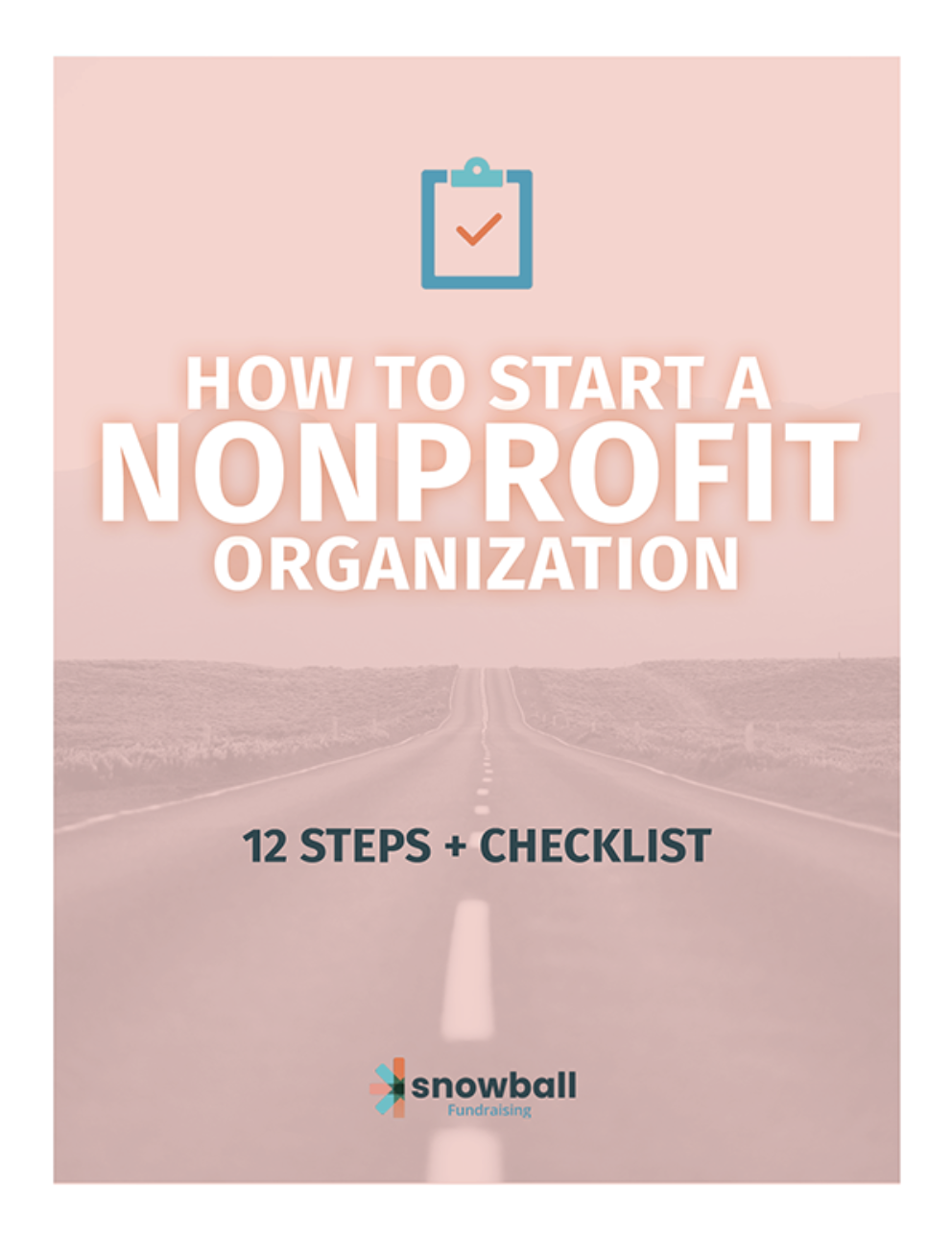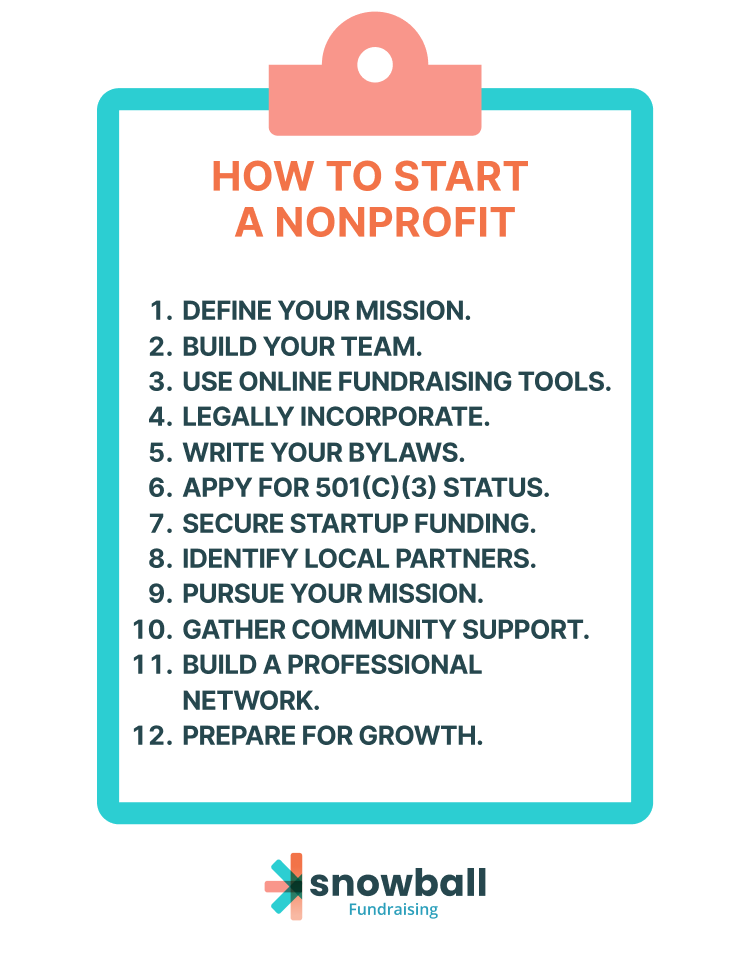
📋✔How to Start a Nonprofit Organization: 12 Steps + Checklist
Inside: Getting Set up, Getting Official & Getting Started
If you’ve decided to start a nonprofit, congratulations! You’re about to embark on a fulfilling journey with an incredible purpose: to do good things in this world. Working in nonprofits is extremely rewarding, but founding your own organization can be a major challenge.
Building an effective, long-lasting organizational structure takes determination and planning— and the right tools. Yet being fully prepared and understanding every aspect of nonprofit work goes a long way to help ease the process.
The following steps are key to establishing and growing your new nonprofit organization.
Use this list to jump to a specific step, or follow along from the top:

As you read through these essential steps, remember that while some may be pursued in whatever order you see fit, others should follow this particular order. For instance, you must write your initial bylaws before applying for 501(c)(3) status, and you must set up your online donation page before you start any fundraising campaigns.
Starting a nonprofit organization is among the most admirable work you can do. You owe it to yourself and your mission to be fully prepared. Follow these essential steps for building an organization that will benefit its community for years to come.

1. Define your nonprofit’s mission.
What first inspired you to start a nonprofit organization? What issue or need do you see in your community that drives you to act?
You already understand your motivations and the goals of your nonprofit’s work, but transcribing and communicating them to others can be more challenging that you might initially assume.
A strong mission statement should accomplish all of the following:
- Clearly express the mission of your nonprofit.
- Focus your organization’s work and relationships.
- Guide your nonprofit’s growth and development.
- Explain your purpose to constituents, donors, and funding bodies.
Remember, a mission statement doesn’t need to explain everything about your nonprofit and its work, but it does need to clearly evoke the essence of your drive and purpose.

Try to keep your mission statement short and sweet— one or two sentences at the most. We walk through more best practices in our longer guide to writing a mission statement.
Taking the time to draft an effective mission statement moving forward is a smart move. Establish a clear mission that defines your driving passion, the actions you’ll take, and the impact you’ll have. This will act as a guiding light as you work through all the steps for starting your nonprofit organization— and it’ll keep your vision focused on the bigger picture.

Take a Personalized Tour
Schedule a demo with one of our fundraising consultants. We’ll show you how the Snowball platform has benefited other nonprofit organizations, and how it can help you.


2. Build your nonprofit’s leadership team.
Next, build a strong team of leaders to help guide the creation of your nonprofit organization. You may already be part of a group that shares a vision and has decided to found a nonprofit together.
If you’re driven by your own individual mission, you’ll need to find partners who share it. Creating a reliable leadership structure composed of passionate, committed individuals is the only way to ensure that your nonprofit’s operations will be sustainable.
The founding participants of a nonprofit organization should include:
- Members of a board of directors
- An executive director
- Other volunteers.
Nonprofit organizations tend to grow out of existing networks of individuals who are brought together by a common goal or interest. If you’re part of a group working together to found an organization, this is where you’ll find these key individuals.
Once your organization has gained its footing, you’ll be able to take on dedicated staff members, compensate your executive director, and create a more extensive leadership structure. You’ll establish an official board of directors comprised of at least three members, and preferably an odd number of individuals.
In the meantime, it’s important to accept help wherever possible but also refrain from taking on too many individuals!
And you must make it easy for your team to work together. This means regular, open communication and easy-to-use systems with multi-user access. Everything should be an open book, and everyone should be on the same page!
Nonprofit organizations tend to operate on extremely slim budgets, especially when they’re young. This, combined with the inherent challenges of founding a nonprofit, means that you must remain focused on your mission and vision.

3. Get up and running with online fundraising tools.
- Fundraising software: An ideal fundraising toolkit will include an online platform for accepting gifts, pledge fundraising options, event planning and registration tools, and data reporting features.
- The thousands of available fundraising tools might seem intimidating at first to the new fundraising professional. Juggling numerous systems will likely complicate, rather than simplify, management of your nonprofit— so look for an all-in-one platform for donations, events, and reports.
- Online donation page: Next, it’s a good idea to get set up with online fundraising tools.
Having your online donation page ready to go when it’s time to start fundraising is a smart way to save time and money. - Many nonprofits struggle to gather momentum throughout the process of initial operations and applying for 501(c)(3) status. This creates the risk of a gap period when you’re in a position to begin fundraising but don’t yet have the basic tools in place to process donations. Since your online donation page will serve as the foundation of your fundraising campaigns, it’s a good idea to start there.
- Text-to-give tools: Now that your fundraising platform is in place, you’ll want to offer easy ways to give and accept donations. In addition to online giving, text-message-based donations are a great way for your nonprofit’s supporters to give on the go.
- Donors text a keyword (such as “give”) to your nonprofit’s text-to-give phone number and then confirm the amount they’d like to give. First-time donors fill out a short donation form with their credit card information. The first-time process takes under a minute; repeat donations take just two clicks.
- A marketing strategy: You will need to think deeply about how to position yourself in the nonprofit—and wider—world. Think about how your nonprofit compares to similar ones, and what sets yours apart.
- Branding isn’t just for commercial businesses. It defines how any organization expresses its goals and conveys its mission. Key tools to market your new nonprofit include your website, social media profiles, and press outreach.
- Matching gift software: One smart way to support your nonprofit’s long-term goals from the start is to embed corporate philanthropy into your fundraising strategy early on. Do this by investing in a matching gift database that embeds into your donation software and website.
The main reason that donors don’t use their matching gift power is simply that they don’t know it exists. Include educational resources in your email newsletters and on your website, and then encourage them to use your database to look up their own eligibility and complete their matches.
With access to these key tools, you’ll be able to collect and store critical donor data, build your support base, and establish long-term relationships. The best part is that many of these fundraising platforms have free tools that are perfect for a newly incorporated nonprofit, with potential upgrades available for your organization as it grows.

4. Legally incorporate to start your nonprofit organization.
In order to move forward with starting your nonprofit, you’ll need to write up a draft of your official charter. Also known as the articles of incorporation, your charter is what defines your new nonprofit as a legal entity.
Officially incorporating your nonprofit is required for eventually receiving 501(c)(3) tax-exempt status, accepting donations, and essentially functioning as a legal nonprofit organization.
Though it may sound intimidating, creating and filing nonprofit articles of incorporation is actually one of the easiest steps in the entire process. Do some quick research on your state’s nonprofit laws, then simply complete the incorporation document with the following information:
- The legal name of your organization
- The official location of its operations
- The names and addresses of all initial trustees, or board members
Each official board member identified in your bylaws then needs to sign the articles of incorporation. Submit this document to your state’s secretary of state office, and you’ve legally incorporated your nonprofit organization!
For more specific guidance, check out this handy template from the IRS that can guide your team as you draft your own founding charter. Of course, this process varies slightly from state by state, so do your research before starting.

5. Write your new nonprofit’s bylaws.
Next, build a strong team of leaders to help guide the creation of your nonprofit organization. You may already be part of a group that shares a vision and has decided to found a nonprofit together.
If you’re driven by your own individual mission, you’ll need to find partners who share it. Creating a reliable leadership structure composed of passionate, committed individuals is the only way to ensure that your nonprofit’s operations will be sustainable.
The founding participants of a nonprofit organization should include:
- Members of a board of directors
- An executive director
- Other volunteers.
Nonprofit organizations tend to grow out of existing networks of individuals who are brought together by a common goal or interest. If you’re part of a group working together to found an organization, this is where you’ll find these key individuals.
Once your organization has gained its footing, you’ll be able to take on dedicated staff members, compensate your executive director, and create a more extensive leadership structure. You’ll establish an official board of directors comprised of at least three members, and preferably an odd number of individuals.
In the meantime, it’s important to accept help wherever possible but also refrain from taking on too many individuals!
And you must make it easy for your team to work together. This means regular, open communication and easy-to-use systems with multi-user access. Everything should be an open book, and everyone should be on the same page!
Nonprofit organizations tend to operate on extremely slim budgets, especially when they’re young. This, combined with the inherent challenges of founding a nonprofit, means that you must remain focused on your mission and vision.

6. Apply for and receive 501(c)(3) status.
Next, build a strong team of leaders to help guide the creation of your nonprofit organization. You may already be part of a group that shares a vision and has decided to found a nonprofit together.
If you’re driven by your own individual mission, you’ll need to find partners who share it. Creating a reliable leadership structure composed of passionate, committed individuals is the only way to ensure that your nonprofit’s operations will be sustainable.
The founding participants of a nonprofit organization should include:
- Members of a board of directors
- An executive director
- Other volunteers.
Nonprofit organizations tend to grow out of existing networks of individuals who are brought together by a common goal or interest. If you’re part of a group working together to found an organization, this is where you’ll find these key individuals.
Once your organization has gained its footing, you’ll be able to take on dedicated staff members, compensate your executive director, and create a more extensive leadership structure. You’ll establish an official board of directors comprised of at least three members, and preferably an odd number of individuals.
In the meantime, it’s important to accept help wherever possible but also refrain from taking on too many individuals!
And you must make it easy for your team to work together. This means regular, open communication and easy-to-use systems with multi-user access. Everything should be an open book, and everyone should be on the same page!
Nonprofit organizations tend to operate on extremely slim budgets, especially when they’re young. This, combined with the inherent challenges of founding a nonprofit, means that you must remain focused on your mission and vision.

For a more thorough explanation, be sure to read our complete guide to the 501(c)(3) application process.

7. Secure some startup funding for your organization.
Nonprofit grant writing can be a major challenge, especially in the earliest days of your organization. However, finding and applying for nonprofit startup grants is extremely important to the launch of your organization.
First, you’ll start by researching the different sources and types of nonprofit startup grants. Funds can be secured from corporations, private foundations, and federal, state, or city governments. Without some initial funding, it can be difficult to reach and engage with the donors who will support your work in the future.
Next, you’ll need to familiarize your team with the grant writing process. If most or all members of your team are new to grant writing, doing some research beforehand will go a long way toward boosting your chances of success. Put generally, the steps of grant writing are:
- Understand your goals.
- Identify grant opportunities and research the sources.
- Build a grant writing team.
- Get started on the proposal, refining your strategy as you go.
- Build a strong case for support.
- Review and submit.
Securing some initial funding early on is the best way for your nonprofit to start pursuing its mission. Continue researching and applying for startup grant funds as you work on the next step, too.

Take a Personalized Tour
Schedule a demo with one of our fundraising consultants. We’ll show you how the Snowball platform has benefited other nonprofit organizations, and how it can help you.


8. Identify local partners for your nonprofit.
Next, identify a few local partners in your community who can help support your launch. At this point in the startup process, deliberately cultivating a local network of partners is beneficial because it builds momentum and keeps everyone excited.
Your community partners will become essential once you actually start reaching out to constituents and donors. It can be very difficult to engage new stakeholders without already having a shared connection.
Think about the local partners who might be interested and useful to your mission, like:
- Local businesses
- Schools and local universities
- Other nonprofit organizations
- Local municipal offices or agencies
Reach out to these partners and emphasize what you have to offer in the arrangement— such as free publicity and boosted corporate social responsibility.
Remember, you’re founding a nonprofit organization to better your community and address a specific problem. Your founding leadership is likely already well connected, but expanding your local network is always a good move. The right connections will unlock new donor bases, marketing outlets, and opportunities to directly pursue your mission.
9. Get started pursuing your mission.

You’ve been excited to get started bettering your community, and now all the official startup processes are out of the way. If you’ve already begun identifying local partners who can give you a foothold in the community, start leveraging those relationships.
You might begin reaching out to donors and engaging constituents in all kinds of ways, including:
Events: Organize an event with a community partner. Maybe an established local nonprofit also focused on improving the community would be willing to help you host and promote a kick-off event. This is a great chance to meet new donors, hear from your neighbors and civic leaders, and promote your first projects.
Pro tip! Before your first event, make sure you have event software set up, so you can sell tickets (if applicable) and collect information about who will be attending.
Donations: In the digital age, it’s crucial for nonprofits to accept both in-person and online donations in various ways. In the last few years, online giving has taken over as the most popular way to give. According to Double the Donation, 55% of millennial and Gen X donors prefer to give online, so you have to meet them where they are.
Pro tip! If you haven’t set up your donation platform yet, now’s the time. You don’t want to lose out on the initial momentum your nonprofit is building.
Relationship building: One of your overarching goals at this point in your nonprofit life should be to build relationships. Developing and nurturing initial relationships with donors and partners will form a strong foundation of support from which your nonprofit can grow. Keep outreach as a top priority, and be sure to nurture any relationships that are already underway.
Pro tip! Set up social media pages and begin building an audience. Ask supporters to share your content, and be sure to invite your following to participate in fundraising events.

10. Begin building a base of support in your community.
Next, build a strong team of leaders to help guide the creation of your nonprofit organization. You may already be part of a group that shares a vision and has decided to found a nonprofit together.
If you’re driven by your own individual mission, you’ll need to find partners who share it. Creating a reliable leadership structure composed of passionate, committed individuals is the only way to ensure that your nonprofit’s operations will be sustainable.
The founding participants of a nonprofit organization should include:
- Members of a board of directors
- An executive director
- Other volunteers.
Nonprofit organizations tend to grow out of existing networks of individuals who are brought together by a common goal or interest. If you’re part of a group working together to found an organization, this is where you’ll find these key individuals.
Once your organization has gained its footing, you’ll be able to take on dedicated staff members, compensate your executive director, and create a more extensive leadership structure. You’ll establish an official board of directors comprised of at least three members, and preferably an odd number of individuals.
In the meantime, it’s important to accept help wherever possible but also refrain from taking on too many individuals!
And you must make it easy for your team to work together. This means regular, open communication and easy-to-use systems with multi-user access. Everything should be an open book, and everyone should be on the same page!
Nonprofit organizations tend to operate on extremely slim budgets, especially when they’re young. This, combined with the inherent challenges of founding a nonprofit, means that you must remain focused on your mission and vision.

11. Build your nonprofit’s professional network.
As your nonprofit gets to work pursuing its mission, you and your team will discover the immense value of developing an extensive professional network.
Building a professional network for your nonprofit can have some major benefits early on— particularly because others who believe in your mission will be happy to promote your work to their own audiences.
Important individuals and groups to connect with might include:
- Other nonprofits in your area of any size or mission
- Nonprofits in the wider region with missions similar to yours
- Digital outlets, such as blogs or news channels, that focus on nonprofits
- Other media outlets related to your mission
- Networks or associations that work in your field
Expanding your network will help to increase visibility for your work, attract new donor bases, and connect your nonprofit with essential resources.

12. Lay some foundations for future growth.
You’ve put in plenty of hard work to get your new nonprofit organization up and running. That’s a real testament both to your passion and the value of your mission.
Now’s the time to plan ahead and invest in your nonprofit’s growth. Having smart development plans in place will greatly reduce any growing pains or internal friction as your hard work continues to pay off.
In addition to building scalable methods into your structures from the very beginning, go ahead and identify some tools that you’ll need in the future, like:
- An adaptable CRM or database system
- New digital donation tools and platforms
- Automated marketing systems
- Volunteer, member, and staff management tools
- Matching gift automation software
Consider how your staffing and leadership strategies will adapt to growth as well. Have strategic plans in place for officially growing your board, instituting membership programs, and creating new staff positions.
Planning for your nonprofit’s successful future is the best way to invest in its stability and healthy growth!
No one works in the nonprofit sphere because it’s easy. Nonprofit organizations are founded for one key reason: to better the world and the communities that comprise it.
If you’ve made the admirable decision to start your own nonprofit, familiarize yourself with the entire process and be prepared to learn as you go! Always be on the lookout for useful resources that can provide you with new insights and resources, like these:
- Best Nonprofit Software to Raise Money Fast. Choosing and managing a digital platform for collecting donations is essential for modern nonprofits.
- Digital Asset Management Software for Nonprofits. Easily define and maintain your nonprofit’s brand and mission with your donors.
- Innovative School Fundraising Ideas. Learn some unique fundraising strategies perfect for new nonprofits with educational missions.
- Fundamental Grant Proposal Template: 8 Crucial Components. Here’s what to know when you’re applying for external funding.
- Nonprofit Digital Strategy: How to Maximize your Online Presence. These key tips will help you establish an effective strategy for your nonprofit organization’s digital marketing.
- Donor Retention: Attracting and Retaining Supporters. Find out how to get your donors returning time and time again.





